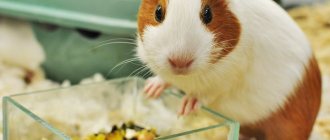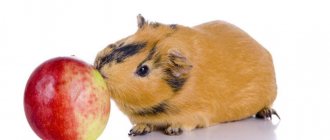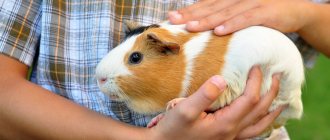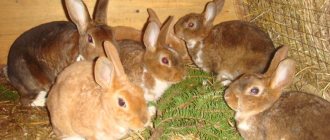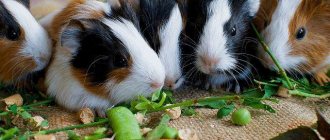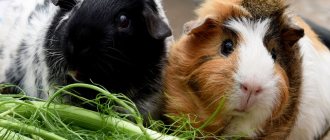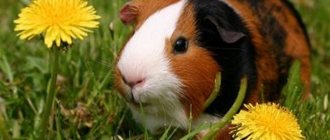Every pet owner wants to treat their pet to a certain treat. Berries or fruits may be ideal as a treat. These products are an important component of the animal's diet and should be included in its daily menu.
The animal’s body has an important feature: the animal is not capable of generating vitamin C on its own, unlike humans. Therefore, the deficiency of this vitamin must be replenished artificially with the help of additional supplements in the diet. If it is not replenished in a timely manner, the mumps may react with paralysis and a number of other health problems. But an excess of vitamin C in the pig’s body can cause skin problems and disturbances in the functioning of the kidney system.
A number of owners are wondering whether it is possible to compensate for vitamin C deficiency with a pear or an apple. It is necessary to take into account that the pear contains about 4.5 mg of vitamin C. In the winter season, the amount of vitamins in the pear is halved, as well as ascorbic acid. Despite all the usefulness of fruits, not all of these types of treats can be given to animals.
What you can feed your guinea pig and what you can’t.
1,597 messages
You can give the following food (food, feed):
Specialized dry food Hay twigs - willow, birch, linden, apple tree Carrots Zucchini Cabbage (white and in small quantities, as it can lead to excessive gas formation and related consequences). Beetroot Bell pepper Apples Pears (in small doses, as they are “heavy” food for the pig’s stomach) Berries Dill Parsley Celery Tops of carrots and beets Greens of sprouted wheat, oats and other grains Cucumbers (from your own greenhouse, since they are often poisoned because of the chemicals in purchased cucumbers, but even your own cucumbers should be given very rarely and in small quantities; cucumbers, due to their high moisture content, wash calcium from the body) Tomatoes (from your greenhouse because they are often poisoned), but not much. In the summer, grass is welcome (dandelions, sedge, clover, squash, plantains, etc.) Turnips Cauliflower Pumpkin Dried apples Corn grains (optional) Green strawberries, strawberries, raspberries - these are leaves Mint Currant leaves Young green peas in pods Peaches, apricots and nectarines (as a delicacy in small quantities, again due to the treatment of these fruits with chemicals) Plantain (do not forget to wash thoroughly) Rutabaga Leaf lettuce - in small quantities only the leaf, excluding leaf petioles if possible. Watercress - leaves in small quantities (can be whole) Head lettuce (in small quantities): oily (shaped like a head of cabbage, the leaf has a greasy sheen, contains many trace elements, nitrates accumulate mainly in the base and core) and Beijing or Chinese (an elongated head of cabbage, white at the base with green tips, it contains a lot of vitamin C, but also a large amount of nitrates in the base and lower parts of the leaf blade, can cause flatulence) - exclude, if possible, areas of lettuce containing nitrates.
Article on the topic: Can guinea pigs eat tangerines, oranges and lemons?
You cannot give such food (food, feed)
Potatoes (in any form) Cereals (rice, buckwheat, millet) in any form, as a separate feed. Use “rolled oats” as the only, constant food Butter (in cereals, in its pure form) Animal proteins (milk, cream, cottage cheese) Watermelons (since now they are not stuffed with anything) Salty, sweet, fried Winter cucumbers, tomatoes, lettuce etc. It’s not advisable if it’s not made by yourself, as there are a lot of chemicals. Sugar Oak branches Citrus fruits (there is an opinion that oranges, tangerines, grapefruits can be given to pigs, but in very limited quantities, without peel (required!) and films) Eggs Meat Milk Fish Green onions Mushrooms Plums (strong laxative) Salad mustard Spinach Sorrel Burdock Sweet tea (I think tea in general) Salt (there are mineral stones for this) Marshmallow Marmalade Chocolate Flowers (all sorts) Chestnuts Horseradish Radish Garlic Crispbread (they contain salt and sugar, as well as other flavoring additives)
Approximate proportions of all products per day: - hay should take up 70% of the pig's diet - this is the main food, - dry special food for guinea pigs - 20% - succulent food (greens, vegetables, fruits) - 10% Hay and dry food should always be present in the cage , just like water! Juicy food is given in small portions 2-3 times a day.
It would also be correct to note that you should not experiment with your pet’s food.
There is an opinion that feeding pigs should be quite conservative, namely: the optimal food is an apple, carrots, a little white cabbage, a lot of hay, good grain + granular food and dill-parsley. In summer and autumn, I give carrot tops, grass picked outside the city, in a clean place, washed and dried, zucchini, cauliflower, cucumbers from the garden.
Article on the topic: List of vegetables and fruits that can be given to guinea pigs
Twigs
Twigs ¶
Good evening! I read that pigs should be given twigs to chew on. And what branches can they use (which trees or bushes) Thanks in advance
Twigs ¶
Good evening! I read that pigs should be given twigs to chew on. And what branches can they use (which trees or bushes) Thanks in advance. Apple trees can definitely be used, probably plums and cherries, but I know for sure lilacs can’t. In any case, I gave exactly these and everything was fine.
Twigs ¶
Twigs ¶
You can: birch, ash, maple, apple tree (dry the branches), alder, pear, willow (all types), rowan, linden. They can be given to the pig “for free use.”
Avoid: tree branches that have seeds in their fruit, i.e. apricot, peach, cherry, plum, etc. (because if they have not been dried for at least 6 months, they may contain cyanogen glucosides, which cause intoxication); branches of coniferous trees; citrus branches like orange, lemon, tangerine, etc. (contain limonin).
Twigs ¶
You can: birch, ash, maple, apple tree (dry the branches), alder, pear, willow (all types), rowan, linden. You can put them “for free use” by the pig. “For free use” does this mean both branches and leaves?
Twigs ¶
Twigs ¶
Twigs ¶
Twigs ¶
And I gave my pigs and the little pig before them apple tree branches with leaves and birch. They tore down the birch tree with buds and whole twigs, and from the apple tree there was bark and young leaves at the entrance))) It seems to me that the animals themselves will not eat something harmful to them, although of course, the risk in this case is not justified and it is better not to try. Give only what is absolutely possible.
Twigs ¶
Do any branches need to be dried for six months?
Twigs ¶
Do any branches need to be dried for six months? No, not any, but only branches of fruit trees whose fruits have pits (cherry, plum, etc.), as well as branches of an apple tree, it is recommended to dry them first.
Twigs ¶
I only give birch and willow twigs (the only ones I can pick when we go to the pond, nothing else “edible” grows there). They go out with a bang! Just be sure to wash and dry!
Twigs ¶
Excuse me, but for example, dry apple tree branches with the leaves? Or can you tear off the leaves and give them fresh and dry the branches?
Twigs ¶
Source
Guinea pigs can be given twigs of cedar, spruce, pine, juniper, fir, which is what we do! They are rich in vitamins, carbohydrates and minerals. The needles contain at least 10% highly digestible protein.
Needles improve digestive activity and appetite, have a beneficial effect on the growth of babies, and have a stimulating effect on sexual hunting in adult animals. The needles contain special bactericidal substances, which in moderate quantities are very useful.
Can a guinea pig have an apple?
Every guinea pig loves to eat delicious food. But their taste is different than ours. Therefore, you need to consider what you offer. For example, oranges and milk are contraindicated for them, but for us they are the norm. First of all, you need to remember that the animal is a herbivore. That is why it requires appropriate nutrition. But can a guinea pig have an apple?
Apples are a traditional dish for pets, along with tomatoes, pears and cucumbers. The variety doesn't really matter, the pet will eat everything. But try to take into account the amount of sugar in the fruit, since you cannot give too much sweets. In general, you can include both fresh and dried apples in your diet.
Apples are included in the guinea pig's diet before the show. They are fed in the evening along with greens, cucumbers, cauliflower and beets. This helps improve your appearance.
Surely every owner understands the peculiarity of his furry, which vitally needs vitamin C. And it is contained in the following products:
- Carrot;
- Cucumbers;
- Apples;
- Black currant;
- Cabbage (cauliflower, white, red);
- Lemon.
Citrus fruits are strictly prohibited. The lemon mentioned above is served as follows. A few drops are squeezed out and added to the drinking bowl. Thus, the body receives the required dose of nutrients and does not cause harm due to high acidity.
By the way, a pig can eat a whole apple on its own. This refers to the incisor teeth, which she uses to bite off a piece, which she then gnaws on. So one piece at a time and there is no fruit, it would seem, such a voluminous product. But you shouldn’t do this, it’s better to cut it into several parts and give no more than 1/4.
To understand the effect of this fruit on the animal, let's understand the nutritional value. Sugar in fruit form is only 16%. Vitamins K, B1, B2, B3, B6, E, PP, P, as well as iron, potassium, calcium and sodium have a positive effect on the entire body.
Article on the topic: What can and cannot be given to rats: nutrition table
Before giving it in dried form, it is better to soak it in water for 2-3 hours. It is important to carefully monitor the freshness; if signs of spoilage are detected, it is better to give the guinea pig another apple.
Those who want to tame a pig also enjoy the delicacy. This is known to be done with your favorite food. Apples and pears are often offered. Fillet should not be overused.
Twigs
Twigs ¶
From: Svinni - April 12, 2007 0:17 Good evening! I read that pigs should be given twigs to chew on. And what branches can they use (which trees or bushes) Thanks in advance
Twigs ¶
Good evening! I read that pigs should be given twigs to chew on. And what branches can they use (which trees or bushes) Thanks in advance. Apple trees can definitely be used, probably plums and cherries, but I know for sure lilacs can’t. In any case, I gave exactly these and everything was fine.
Twigs ¶
Twigs ¶
From: Galina - April 12, 2007 4:54 am
You can: birch, ash, maple, apple tree (dry the branches), alder, pear, willow (all types), rowan, linden. They can be given to the pig “for free use.”
Avoid: tree branches that have seeds in their fruit, i.e. apricot, peach, cherry, plum, etc. (because if they have not been dried for at least 6 months, they may contain cyanogen glucosides, which cause intoxication); branches of coniferous trees; citrus branches like orange, lemon, tangerine, etc. (contain limonin).
Twigs ¶
You can: birch, ash, maple, apple tree (dry the branches), alder, pear, willow (all types), rowan, linden. You can put them “for free use” by the pig. “For free use” does this mean both branches and leaves?
Twigs ¶
From: Galina - April 13, 2007 5:45 am
For free use - this means that the twigs (with or without leaves) can always be at the disposal of the pigs, they do not need to be limited. Here’s another example for you, a statement from the forum: My pigs get plenty of hard feed and their bite is fine. In the summer, I stocked up on apple branches with leaves (one of my favorite treats) as an additional diet; in addition to the leaves, she also eats branches, nibbles them off and eats them, chewing them thoroughly.
Twigs ¶
From: Svinni - April 13, 2007 2:45 pm
Can pigs have cherry branches and leaves? And I didn’t quite understand something, can I have imiren or not?
Twigs ¶
From: Galina - April 14, 2007 0:49
Can pigs have cherry branches and leaves? And I didn’t quite understand something, can I have imiren or not? I don't know anything about lilacs. The only thing I can say is that I have never seen a single animal that would eat it, and I have never even seen caterpillars on it. Cherry branches may contain the same substance as the fruits inside in the pits - albeit in smaller quantities, and it is toxic. That’s why it is recommended to dry cherry branches (and all fruit trees with seeds) for six months before giving them to the pig.
Twigs ¶
From: L_enok - April 14, 2007 2:50
And I gave my pigs and the little pig before them apple tree branches with leaves and birch. They tore down the birch tree with buds and whole twigs, and from the apple tree there was bark and young leaves at the entrance))) It seems to me that the animals themselves will not eat something harmful to them, although of course, the risk in this case is not justified and it is better not to try. Give only what is absolutely possible.
Pear for a guinea pig: is it possible or not?
The ancient expression “hunger is not an aunt” is relevant not only in the human environment. As for our smaller brothers, this is perhaps doubly true. Take a guinea pig: if it remains hungry even for a very short time, it can be dangerous for its health.
Therefore, future owners of these domesticated rodents are always warned: the pet’s feeder should not be empty! If an animal doesn’t eat its ration right away, it will certainly eat it later; it doesn’t suffer from a lack of appetite and absorbs whatever you give it.
And in between feedings, he will chew something - for example, hay, which is necessary both for grinding down teeth and for improving the digestive process.
Apples are good for everyone
I would like to read about whether it is possible to feed apples to cows and pigs. If so, how healthy are fruits in general?
A. Davydov.
Fruits are a source of vitamins, minerals and organic substances, which are found in fruits in the form of animal compounds that are well absorbed by the body and play an important physiological role in metabolism.
Fruits are wonderful foods. They contain many sugars and organic acids in easily digestible forms.
An important component of the diet
The pig's body has one peculiarity: it is not able to synthesize vitamin C, which is essential for life. Therefore, its deficiency should be constantly replenished with products that contain ascorbic acid.
A lack of vitamin C can cause paralysis for your pet. But there is also a flip side to the coin: if this vitamin enters the body in excess, it can cause a predisposition to kidney disease and skin irritations.
As for the content of this substance in the proposed food, this fully applies to
- fresh vegetables,
- fruits,
- berries, i.e. to what is called succulent food.
Article on the topic: Is it possible to give sorrel to guinea pigs?
However, not all of them are indicated for guinea pigs. Is it possible to offer these pets a pear among all the abundance of fruits and berries?
As for the same vitamin C, 100 grams of pear contains 4.5 mg. In winter, during long-term storage, the vitamin composition is reduced, and ascorbic acid decreases by one third.
Results
Guinea pigs are unpretentious in maintenance and care and are not picky about food. At first glance this seems like too many restrictions. In fact, the rule is simple: food should be healthy, low-fat, free of chemicals, spices, salt, and not irritate the esophagus. Grains, greens, most fruits and vegetables, branches of fruit trees - the list of permitted products is very large. In addition, you can always buy ready-made balanced grain mixtures in the store.
Sources:
https://animallittle.ru/mozhno-li-vinograd-krysam.html https://nalugah.ru/zhivotnovodstvo/morskie-svinki/chem-mozhno-i-nelzya-kormit-morskuyu-svinku.html https:// msvinkam.ru/pitanie/chto-nelzya-morskim-svinkam.html
How much, how and when?
Experts, noting that a guinea pig can be pampered with such a delicacy, nevertheless recommend giving this fruit rarely - as a treat, and in small doses: for the animal’s stomach, a pear is considered a heavy food.
When feeding adults two or three times a day, as a rule, succulent food, including pear, is given for breakfast. 80 g per dose will be enough. One and a half times more can be offered to females who are expecting a new addition to the family or are already breastfeeding mothers, as well as those belonging to the skinny breed - they have a great appetite! It is possible to make dinner the same with vitamins.
The fruit must be thoroughly washed and cut into fairly large pieces - there is no need to chop or cut into fractional cubes.
In principle, it is allowed to treat a rodent to a pear without peeling it, but be sure to remove the seeds.
Keeping a gerbil
3.Check the drinking bowl every day. There should always be water in it.
4. Monitor the composition of the mixture you feed. It should not contain a lot of seeds (because of them, gerbils can get fat). It is not recommended to give cabbage, grapes, citrus fruits, because... they are bad for their stomach.
6.Do not keep your gerbils cage in direct sunlight. Give them some kind of box or house so that they can rest and hide there.
7.Always make sure that the gerbil's cage is tightly closed and latched. Because These animals are great lovers of climbing everywhere and are excellent jumpers.
8. Do not hold gerbils by the tail (except at the very base). You may damage it. It is also not recommended to put a wheel with horizontal bars in their cage, as they can pinch their paws or tail.
9. Use sawdust, special rodent litter, or wood-based cat litter as filler. It is not recommended to use sawdust from coniferous trees due to their specific odor and oils. To encourage gerbils to make a nest for themselves, provide them with hay or pieces of paper. Do not put cotton wool, wool, mohair or other fibrous materials, as gerbils can get tangled in them and damage their paws. Do not use clay-based cat litter as gerbils have a habit of trying everything on their teeth, and they can be poisoned by it.
10. Clean the cage once every 1-2 weeks with warm water. It is advisable to disinfect it once a month.
Source
What you need to know
Pears contain a large amount of easily digestible sugar, and sweets are harmful to the guinea pig’s body, so you should not include them in the daily menu.
Bloating, indigestion - such troubles can await a gourmand. And if this fruit is given in combination with water, it can cause diarrhea.
Juicy food, including pear, is introduced into the diet of animals in autumn and winter, when there is practically no green food. It should be borne in mind that vegetables and fruits should make up 1/5 of the daily menu.
Article on the topic: How do turtles winter in nature and at home, will they survive in a pond in winter?
You can give from two to four types of vegetables and fruits per day.
Any new food for pigs is given gradually, in small portions.
The pig will express its taste preferences for a particular product by leaving it uneaten during the day. Then the delivery of such a “dish” can either be reduced or stopped altogether.
You should not give the pear in the form of dried fruit - it contains even more sugar than a fresh pear.
Some sources say that it is permissible to feed guinea pigs leaves and young pear twigs.
It is strictly forbidden to bear fruit:
- polluted,
- unripe,
- overripe,
- moldy,
- rotten.
Almost all breeds of guinea pigs need the same diet. As for eating pears, there is always a caveat: infrequently and a little.
Considering all of the above, it is logical to come to the conclusion: the wisest thing is to carefully monitor the tastes and behavior of your pet, they are all individual. If “too much fruit” causes diarrhea in most animals, some, on the contrary, will suffer from constipation, while others will eat it with pleasure without any health consequences.
What to do if your hamster runs away.
If you have adopted a hamster, then you must definitely purchase a cage or put the hamster in some kind of container, otherwise, with its small size, it will not be possible to find it soon if it manages to escape.
If, despite all your fears and warnings, the hamster still runs away, then you need to find it as quickly as possible, because such a small pet faces many dangers when it is outside its living quarters. So what to do?
Ask everyone to be quiet and, if possible, not to turn on the TV or other objects that may make sounds. Walk around the rooms, listen to see if you hear any rustling in the corners or places where there is paper or cardboard. You may also hear scratching. If you hear rustling noises in some place, approach as quietly as possible and pick up the hamster in your arms.
Scatter grains or pieces of his favorite dish throughout the apartment. Just don’t forget that hamsters are very thrifty, so scatter the very minimum amount of food. The next day (if the hamster is still in the apartment) you will see in which room the most treats were eaten, which means the hamster is in that room. Before you find the hamster, it is recommended to close all doors and windows in this room to prevent it from moving to another room.
During the day you can search in hidden places, corners, closets. Because it is during the day that they prefer to sleep and for this they look for a warmer and softer place.
You can glue small rolls from cardboard and place them around the apartment or in the room where it might presumably be located. On the same day you will definitely find him sleeping in one of the rolls.
Place a three-liter glass jar in the middle of the room and fill the bottom of the jar with grain. Make a special lift next to the jar so that the hamster can climb into the jar for a treat. If he gets in there, he won't be able to get back out.
And lastly, don’t worry if all your attempts are unsuccessful. Usually, hamsters come out of their hiding place on their own after a few days.
Preventing "escape":
As absurd as it may sound, a cage is not always the best option for preventing a hamster from escaping. In addition to purchasing a cage, you need to be careful: check whether the cage door is closed, try not to open it again, and if there are children in the house, explain to them that it is better for the hamster to live in a cage, so you should not open it too often.
But also don’t forget that you can provoke the hamster’s escape. It is important to know how you should and should not handle your hamster.
Under no circumstances should you do this:
- It is rude to pick up a hamster by the scruff of the neck.
- stand near the cage and scream.
- sudden movements and waving your arms.
- leave it on high places, the hamster will fall in any case if you don’t remove it yourself.
- take him from the sleeping cage, it is better to wait until he wakes up.
- cover the hamster with your palms or drive it into a closed space.
Recommended:
— talk to him in a calm, peaceful voice.
- before petting the hamster, give him your hand to sniff.
- you need to pick it up slowly and without sudden movements; with your other hand, grab the hamster under the front legs.
- if the hamster is scared, you need to let him calm down first, and then pick him up or play with him.
A hamster, like any other pet, needs care, attention and affection. Provide him with all this, and he will never run away from you, at least his reasons will no longer be of a personal nature, but, for example, because he was given the opportunity to escape by forgetting to close the cage. But there were cases when hamsters did not run away when the cage was open, most likely this was due to the good care he received, the warmth and affection that he received from his owners. Take care of your pets!
Diet
Depends on the physiological state. So, adult animals are always fed in the morning and evening at the same time. For pregnant pigs, feed is increased to 4 times a day.
It is important to understand that a hunger strike is unacceptable for rodents, as is a sudden change in diet. Any new product is introduced gradually and in small doses
Overeating also has a negative effect - diseases of the intestinal tract and obesity will be ensured.
An approximate diet of what guinea pigs eat per day is presented in the tables.
Possible diet depending on the time of year (per day)
| Type of feed | Winter | Spring | Summer | Autumn |
| Vegetables, city | 100 | 100 | 100 | 100 |
| Root vegetables, | 30 | 30 | 20 | 20 |
| Fresh greens, | — | — | 300 | 300 |
| Seno, city | 10-20 | 10-20 | — | — |
| Bread, Mr. | 20-30 | 20-30 | 10-20 | 10-20 |
| Grain, city | 40 | 40 | 30-40 | 30-40 |
| Milk, ml. | 20 | 20 | 20 | 20 |
Nutrition for young and adult guinea pigs (daily ration)
| Adults | Young | |
| Grain, city | 30-40 | 20 |
| Bran, Mr. | 15 | 10 |
| Seno, city | 60 | 30-40 |
| Green, city | 500 | 200-300 |
| Root vegetables, | 100 | 50 |
| Milk, ml. | 15 | 5-10 |
If you answer the question of which food is better, then experts do not have a common opinion on this matter. Many are inclined to think that this is oat bran, carrots and beets, as well as hay in winter or grass in summer. Other professional breeders are not against constantly feeding animals with high-quality and well-balanced factory-made feed.
Serving Size
There are three apple-related factors to consider when feeding your guinea pig apples:
- High sugar content;
- A large amount of vitamins;
- High concentration of acids.
It is better to cut the fruit. All these components, if contained in excess, can lead to digestive disorders, irritation of the mucous membranes and deterioration of the pet’s condition.
In this regard, you should feed your guinea pig fresh apples no more than three times a week. Moreover, it is worth giving it 2 - 3 slices, depending on the size of the fruit.
Dried fruits can be given in a bowl - every day in the morning, 3 - 4 slices.
But you cannot collect these seeds, store them separately for a long time and pour them out to your pet by the handful. The fact is that the skin of the seeds contains cyanic acid. Its concentration increases over time, making them poisonous. A large number of seeds, especially after long-term storage, lead to serious poisoning of the body and even the death of the pet.
Thus, a guinea pig can be fed fresh apples three times a week, and dried apples every day in the morning. Do not give soaked or compote-boiled apples. Apple seeds can only be given from fresh fruit in a few pieces; the seeds cannot be collected and stored separately, as extremely toxic cyanide acid accumulates in them.
Grain nutrition scheme
In practice, guinea pig breeders choose one of two ways to feed their pets:
- grain;
- grain-free.
The grain-based method of nutrition involves the use of ready-made store-bought mixtures: grain or granulated. High-quality products from trusted manufacturers contain a rich set of minerals and other substances vital for the animal. Of course, such food should not constitute the entire daily diet of the pig, but only about 20%. The fruit and vegetable share is also 20%. Another 10% is greens, the rest is hay.
Attention! Good food is not cheap. Cheap analogues are made using simplified technology
They are useless or even harmful to the pig.
Important nuances in this matter:
- Dry food is good for a rodent's teeth, but hard on the stomach. Give it no more than 1 tbsp. l. per day, together with juicy greens or vegetables.
- Dry mixtures are not suitable for dramatically expanding the diet. Introduce them gradually, with 0.5 tsp. for one meal.
- This method of eating is characterized by increased calorie content. It must be combined with the pet's active lifestyle.
General feeding rules
The recommended daily ratio of all types of food looks like this:
- dry food – 5-10% (no more than a tablespoon);
- juicy food – 30%;
- hay – 60%.
If there is no dry food on the menu, an adult pig should eat approximately 150 g of vegetables per day. She is served vegetables every day, and is occasionally pampered with berries and fruits. Vegetable dishes must be supplemented with leafy greens, which compensate for the lack of vitamins.
Do not keep your rodent on a mono-diet, feeding it only carrots or beets: this will cause health problems. It’s great if there are different products on his table every day: parsley will be replaced by dill/basil, and celery by carrots/zucchini. A typical daily diet consists of three types of vegetables and herbs.
Do not forget to establish an uninterrupted supply of hay (especially during the cold period): the guinea pig chews it constantly, without limiting itself in volume. Hay normalizes digestion and is necessary for proper grinding of teeth.
Legume and legume-cereal hay is considered the most valuable. The rodent will also thank you for the vitamin herbs (nettle, alfalfa and clover) that you will prepare in the summer. These plants will be an excellent feed for growing and pregnant animals.
Prohibited Products
Well, let’s make a reservation about what you should not feed your guinea pig. There is a taboo against onions and green onions, which are toxic to rodents. Rhubarb, which contains large amounts of oxalic acid, is not recommended for consumption. For the same reason, sorrel is taboo. You should also not include eggs, which contain animal protein, in your diet. Even one egg can harm a pet’s body. Well, sugar, which causes diabetes, is prohibited.
It is strictly forbidden to give rodents herbs that contain poison: fern, aloe, celandine, snowdrop, foxglove, honeysuckle, etc. We will not list all the plants, due to the fact that there are a lot of them. In order not to harm your pet, it is enough to give only those green foods that you know and which are included in the list of approved products for small rodents.
What guinea pigs CANNOT eat: PROHIBITED PRODUCTS / Guinea pigs show / SvinkiShow
What do guinea pigs eat? Juicy food / SvinkiShow
Guinea pigs. Top 10 favorite foods / SvinkiHotel
TOP 10 Most Dangerous Things for Guinea Pig / Pig Show / SvinkiShow
Diet of Guinea Pigs in Winter: JUICY FOOD / SvinkiShow
Vegetable menu
The main task of vitamin C in the rodent body is to control the functioning of connective and bone tissues. Animals have to look for it from external sources, since the animal body is not able to produce it in such quantities.
Pigs' favorites on the menu most often include apples, carrots and cucumbers. Vitamin C can enter the animal’s body through raw food of plant origin.
It is important to give them to your pet at least 1 teaspoon per day. Veterinarians also list the following as approved products:
Veterinarians also list the following as approved products:
- Zucchini is allowed due to its high content of minerals and pectins, which normalize the functioning of intestinal permeability.
- Carrots have a positive effect on the condition of the animal’s coat and skin, as well as visual and auditory function. You can give not only the fruit itself, but also well-washed tops. Due to the content of Vitamin A, urine may turn orange.
- Bell pepper can be given to animals only during the season, due to the fact that winter varieties are oversaturated with nitrates. Only sweet varieties are allowed to serve as food.
- Pumpkin is also given to the animal almost completely. And zinc contained in the seeds is a strong preventative against helminthiases.
- Cucumbers themselves are low in calories, safe and have the ability to help digest heavy fats.
- Fresh peas are also acceptable, but in small quantities. Despite the disapproval of veterinarians. Some food manufacturers add the essence of the fruit to their mixtures, despite the fact that they can cause a negative side reaction in the animal.
- Cabbage is also allowed, but subject to proper supervision. While it causes gas in some people, excessive use can be dangerous for pigs. It is worth introducing it into the diet gradually, observing the reaction of your friend.
- Rutabaga facilitates bowel movements and helps avoid constipation. Best suited for your pet's winter diet.
- Jerusalem artichoke can be given as a treat, strictly limiting its total amount in the animal’s diet. The root vegetable itself is the most dangerous; other parts of the plant can be given constantly.
The most undesirable products include:
- Tomatoes are especially considered dangerous when green. They contain solanine, in addition, the use of tops is also not recommended. Ripe tomatoes, due to the destruction of poisons, can be included in the diet in small quantities. If you overdo it, the animal may experience intestinal upset and problems with the gastrointestinal tract.
- Potatoes are prohibited due to starch and solanine.
- Melon has a risk of developing diabetes due to the abundance of sugars.
- Radish and radish oils can cause bloating.
- Beetroot has a stable effect and is not particularly recommended for pregnant females. Root vegetables and tops are recommended for healthy individuals in small quantities. After eating beets, the animal’s urine may temporarily acquire a red tint.
- Corn is prohibited for pigs; only tops are allowed. And grains contain a large amount of starch, which can cause obesity.
Benefits of vitamins
Vitamin A"
- needed for growth, nervous system, vision. Included in feed of plant origin.
Vitamin "B1"
- participates in the metabolism of carbohydrates and proteins. Found in grains and young shoots.
Vitamin B2
- Contained in enzymes that regulate oxidative processes.
Vitamin B6
- needed for the formation of hemoglobin in the blood. A sufficient amount of this vitamin is found in milk and cereals.
Vitamin B12
- plays an important role in the body’s use of protein and is involved in the metabolism of certain amino acids. For the animal’s normal well-being, guinea pigs’ diet should include foods with this vitamin.
Vitamin D
— ensures the normal course of bone growth. As in the human body, it is synthesized under the influence of sunlight.
Watermelon
Guinea pigs can be given a little watermelon during the summer season. Try to give ripe pulp, and it is advisable not to give the white part closer to the rind, since it is in this part that nitrates accumulate. For the same reason, pigs should not be given early vegetables. Watermelon is a diuretic, so indulge your pet with it infrequently.
The same goes for melon. This vegetable is given from your own garden or purchased in season. It is also not recommended to give melon frequently; it is very sweet and can contribute to the development of diabetes.
We tried to consider in as much detail as possible and give answers to the question “What vegetables can guinea pigs eat?” As you can see, most vegetables are not only possible, but also should be given to guinea pigs. The most important thing is a properly formulated and balanced diet for your pet, including products grown without chemicals. To keep your guinea pig healthy and cheerful, stick to proper nutrition and your pet will thank you with its playful behavior and healthy appearance.
So, we have dealt with the question of what vegetables can guinea pigs eat, but we described in this article whether your pet can eat grass. You may be interested in this information.
https://nalugah.ru/zhivotnovodstvo/morskie-svinki/chem-mozhno-i-nelzya-kormit-morskuyu-svinku.htmlhttps://msvinkam.ru/pitanie/chem-kormit-morskuyu-svinku.htmlhttps:// moy-homyachok.ru/morskie-svinki/kakie-ovoshhi-mozhno-morskim-svinkam.html
Solid food
Solid (roughage) food consists of grains, hay, and special food in granules, which is available in pet stores. You don’t have to give special food, but when there is no grass or hay, it is the best option. These animals love to eat this food, just as birds peck their favorite grains. Now you can buy ready-made feed in granules, intended specifically for these animals; these granules contain vitamin C. The feed contains this vitamin, it should not be stored for a long time, no more than three months. This food must be stored in a dry place, in tight packaging, otherwise it may become moldy and spoiled, becoming unsuitable for consumption.
